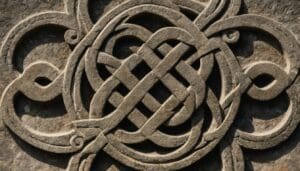Celtic Mythology on TV: American Gods’ Mad Sweeney

Updated On: November 07, 2023 by Ciaran Connolly
American Gods is a fantasy-drama television series based on British author Neil Gaiman’s novel of the same name, published in 2001. Its premise is unique. The show opens with Shadow Moon, the protagonist, who is told that his wife Laura has been killed in a car crash just days before he is due to be released from prison.
He is released early to attend her funeral, and during his travels, he becomes mixed up in a myriad of strange events involving a mysterious patriarchal figure who goes by the name Mr. Wednesday.
Mr. Wednesday offers Shadow a job as his bodyguard which Shadow eventually accepts, plunging him into a cryptic world previously unknown to him. He learns that there’s a growing conflict between the traditional Old Gods who fear irrelevance in modern culture – gods of religion and culture that were brought to America by immigrants who worshipped them and passed them down through the generations – and the New Gods – gods of society, technology and globalisation. The show follows Mr. Wednesday and Shadow as they recruit Old Gods for this upcoming battle to defend their existence.
This tension between the Old Gods and New Gods is the central theme of the show. It explores how the traditional gods of classic mythology from around the world were bleeding followers to the New Gods, a new pantheon reflecting modern society’s obsession with materialism, especially money, media, technology, celebrity culture and drugs.
Irish Folklore on TV: American Gods’ Mad Sweeney
One of the show’s main writers, Bryan Fuller – whose other works include Pushing Daisies, Hannibal, and Star Trek – stated that he wanted the Old Gods to be portrayed as gritty and rustic to ‘demonstrate the well-worn aspects of their religion and the consequences of going without faith for so long’, while the New Gods are portrayed as slick and updated with their technology to illuminate ‘how valuable and pertinent they are, in their religions’.

Down-on-his-luck: Mad Sweeney
Mad Sweeney is introduced as a down-on-his-luck leprechaun – a type of fairy from Irish folklore, part of the supernatural aos sí race – who is employed by the enigmatic Mr Wednesday. Given his enormous stature (6 foot 5 inches), his status as a leprechaun is a source of mystery throughout the show, as is his background for his time in America has affected his long-term memory. He recalls enough about his past to disclose to Laura, Shadow’s wife, that the influx of Christianity impacted his early Celtic and Pagan life: ‘Mother Church came along and turned us into saints, and trolls, and fairies’.
Mad Sweeney’s identity is ultimately revealed by Mr Ibis, an Old Egyptian god of death: ‘You were a God-King. You were the god of the sun, of luck, of craft, of art, of everything valuable to civilisation. The Shining One, they called you’.

Irish Folkore: Buile Shuibhne and King Lugh
Mad Sweeney’s name, it is revealed, is a reference to Buile Shuibhne, a king from Irish folklore who goes mad. The story goes that he fled on the eve of the Battle of Mag Rath in AD 637 after seeing a premonition of his death in the flames of his fire, and was cursed for his cowardice by St. Ronan to madness and wandering Ireland until he died in the form of a bird. He was brought to America in the 1700s by Irish immigrants, and although he slowly lost his memory the shame of fleeing never left him. His involvement with Mr Wednesday is his way of redeeming himself.
Mad Sweeney’s character and backstory are chiefly based on King Lugh of the Tuatha Dé Danann, one of the most distinguished gods of Irish mythology. Known as The Shining One, Lugh of the Long Arm, Lleu of the Skilful Hand, Son of the Hound, Fierce Striker, and Boy Hero, King Lugh was a warrior, a king, a master craftsman and a saviour of the Irish people. He is associated with oath bindings, truth and the law, rightful kingship, and skill and mastery in multiple disciplines, including the arts. He corresponds to the pan-Celtic god Lugas and has been likened to the Roman god Mercury.
In Irish mythology, Lugh is the son of Cian and Ethniu. He is the maternal grandson of Fomorian tyrant Balor, whom Lugh kills in the Battle of Mag Tuired. His foster-father is the sea god Manannán. Lugh’s son is the hero Cú Chulainn, who is believed to be an incarnation of Lugh, a popular motif in Irish folklore.
Although Mad Sweeney’s appearance in American Gods adheres to a more stereotypical image of an Irishman with his Celtic red hair, in the traditional mythology Lugh is described as: ‘A man fair and tall, with a great head of curly yellow hair. He has a green mantle wrapped about him and a brooch of white silver in the mantle over his breast. Next to his white skin, he wears a tunic of royal satin with red-gold insertion reaching to his knees. He carries a black shield with a hard boss of white-bronze. In his hand a five-pointed spear and next to it a forked javelin. Wonderful is the play and sport and diversion that he makes (with these weapons). But none accosts him and he accosts none as if no one could see him’.

American Gods portray the battle King Lugh is most famous for: Battle of Magh Tuireadh. Using magical artefacts gathered by the sons of Tuireann, King Laugh rouses his army with a speech that elevates their spiritual status to that of a King or god-like himself. Lugh faces his grandfather Balor, who opens his evil poisonous eye that kills all it looks upon, but Lugh shoots his sling-stone that drives his eye out the back of his head, killing him. King Lugh beheads him for good measure.
Weapons and Familiars
King Lugh was bestowed many gifts during his time as High King.
- Lugh’s Spear: the Spear (Sleg) of Assal, one of the Four Jewels of the Tuatha Dé Danann. Brought to Ireland from the island Gorias by the aos sí, it was said to be indestructible and took the form of lightning when thrown. He used it to behead his grandfather Balor ar the Battle of Magh Tuireadh.
- Lugh’s Slingshot: he wielded it in the battle against Balor of the Evil Eye (some accounts say it was the cause of Balor’s death, while others say it destroyed his Evil Eye). According to a poem recorded in Egerton MS. In 1782, rather than using ordinary stones, King Lugh launched a tathlum, a stone-like weapon composed of the blood collected from toads, bears, the lion, vipers and the neck-base of Osmuinn, mixed with the sands of the Armorian Sea and the Red Sea.
- Fragarach, the sword of Nuada: known as ‘The Whisperer’, ‘The Answerer’, or ‘The Retaliator’, this sword belonged to the first High King of Ireland. It was bestowed upon King Lugh by Nuada, who proclaimed Lugh king after deeming himself to be unworthy of kingship after losing his arm in battle. The sword originally belonged to Manannán, King Lugh’s foster-father, king, warrior, and sea-god of the Otherworld.
- Lugh’s Horse
Given to him by Manannán, Lugh’s horse Aenbharr could fare on both land and sea and was said to be swifter than wind.
- Lugh’s Hound
Failinis was a fierce greyhound who was given to King Lugh as a forfeit by the King of Loruaidhe in Oidhead Chloinne Tuireann. It was said that he could turn water in wine, always catch his prey, and be invincible in battle.

Interested in more Irish stories?






